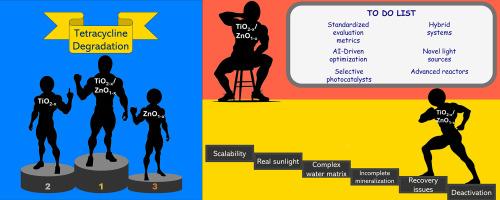Photocatalytic degradation of antibiotics in water via TiO2-x: Research needs for technological advancements
IF 5.4
Q2 ENGINEERING, ENVIRONMENTAL
引用次数: 0
Abstract
Antibiotic contamination in water systems poses significant risks to public health and ecosystems by contributing to antibiotic-resistant bacteria proliferation. Conventional water treatment methods often fail to remove these pollutants effectively, necessitating more efficient technologies. Recent advancements in TiO2-x photocatalysts for antibiotic degradation in water have shown promise. Strategies to optimize TiO2-x photocatalysts include doping, heterojunction formation, and hierarchical nanostructure design. Studies demonstrate significant improvements in antibiotic degradation under both ultraviolet and visible light, with some achieving complete mineralization. However, challenges remain in scaling up to real-world applications, including maintaining efficiency in complex water matrices, developing efficient recovery methods, ensuring long-term stability, and addressing environmental risks of nanoparticle release. Key research directions for technological advancement include rigorous testing under actual solar conditions and exploring nontraditional light sources like LEDs for 24-h operation. Developing multifunctional photocatalysts capable of simultaneous antibiotic degradation and bacterial inactivation is crucial. Increasing selectivity towards specific antibiotics through molecular imprinting techniques and integrating TiO2-x with other advanced oxidation processes and biological treatments for synergistic effects are important areas of focus. Designing scalable synthesis methods and innovative reactor designs for large-scale implementation is essential. Establishing standardized evaluation metrics for meaningful performance comparisons and conducting comprehensive environmental impact assessments of nanoparticle release are necessary. Leveraging artificial intelligence for rapid material optimization and predictive modeling of photocatalytic processes shows great potential. Synthesizing current knowledge and highlighting these research priorities, this review aims to guide the development of effective and sustainable water treatment solutions for antibiotic contamination.

通过 TiO2-x 光催化降解水中的抗生素:技术进步的研究需求
水系统中的抗生素污染会导致耐抗生素细菌大量繁殖,从而对公众健康和生态系统构成重大威胁。传统的水处理方法往往无法有效去除这些污染物,因此需要更高效的技术。用于降解水中抗生素的 TiO2-x 光催化剂的最新进展已显示出良好的前景。优化 TiO2-x 光催化剂的策略包括掺杂、异质结形成和分层纳米结构设计。研究表明,在紫外线和可见光条件下,抗生素降解效果明显改善,有些还实现了完全矿化。然而,在扩大实际应用方面仍然存在挑战,包括在复杂的水基质中保持效率、开发高效的回收方法、确保长期稳定性以及解决纳米粒子释放的环境风险。技术进步的主要研究方向包括在实际太阳能条件下进行严格测试,以及探索 LED 等非传统光源的 24 小时运行。开发能够同时降解抗生素和灭活细菌的多功能光催化剂至关重要。通过分子印迹技术提高对特定抗生素的选择性,以及将 TiO2-x 与其他高级氧化过程和生物处理方法相结合以产生协同效应,都是重要的关注领域。为大规模实施设计可扩展的合成方法和创新的反应器设计至关重要。有必要为有意义的性能比较建立标准化的评估指标,并对纳米粒子的释放进行全面的环境影响评估。利用人工智能进行快速材料优化和光催化过程预测建模显示出巨大的潜力。本综述综合了当前的知识并强调了这些研究重点,旨在为开发有效、可持续的抗生素污染水处理解决方案提供指导。
本文章由计算机程序翻译,如有差异,请以英文原文为准。
求助全文
约1分钟内获得全文
求助全文
来源期刊

Journal of hazardous materials advances
Environmental Engineering
CiteScore
4.80
自引率
0.00%
发文量
0
审稿时长
50 days
 求助内容:
求助内容: 应助结果提醒方式:
应助结果提醒方式:


